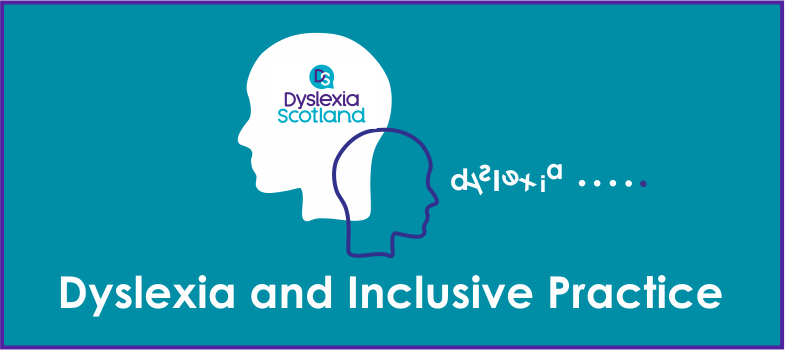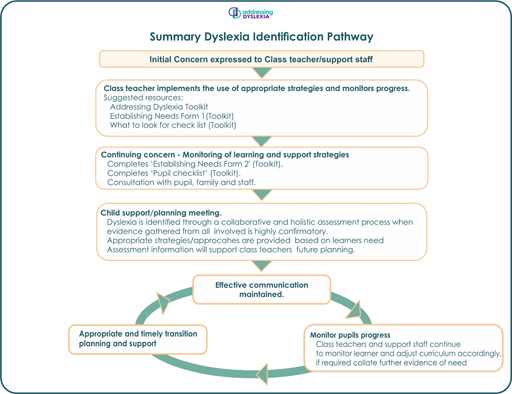2.2.1 What is Assessment?
“Assessment should be viewed by teachers as an on-going process, rather than a one-off event…” (SOEID 1998 COUNT ME IN)
The Addressing Dyslexia Toolkit uses the following rationale which also supports the national approach for Getting It Right For Every Child (GIRFEC).
Rationale
Assessment is a dynamic process within learning and should actively involve teachers/school staff, management, parents, pupils and other agencies when there are concerns about pupil progress.
The process takes a holistic approach and includes consultation and the gathering of information from varied sources in order to verify the needs of a pupil and to suggest intervention appropriate for the pupil.
The process should support pupils to become successful learners and confident individuals.
Assessment acknowledges that children and young people develop as a result of an interaction between themselves and their environment. The assessment practice is highlighted by the SHANARRI indicators to be:
- conducted over time and across different contexts
- minimally intrusive, whilst achieving the best outcome for the child/young person;
- inextricably linked to intervention in such a way, that the assessment is formative and provides results that inform any required intervention;
- built upon and inform the on-going cycle of assessment, planning, intervention and review. In terms of best practice, be negotiated within a multi-agency, staged intervention framework;
- collaborative and working in partnership with parent(s)/carer(s), the child or young person, and those who work most closely with the child or young person; and
- mindful to consider and promote the young person’s strengths for learning
Action taken is a result of the interpretation of the assessment process and should follow current legislation –
- Additional Support for Learning
- Guidelines/Code of practice
- Children and Young People (Scotland) Act 2014
Interventions implemented should develop the pupil’s resilience and ability to fulfil his/her potential.
ASPEP (The Association of Scottish Principal Educational Psychologists) Position Paper Educational Psychology Assessment in Scotland (2014)
What is a holistic or collaborative assessment?
In module 1 you downloaded files to support the holistic and collaborative process of identification.
Module 1 section 2.2 highlighted that the identification process for dyslexia should be a holistic/collaborative process and include the following:
- Talking with all relevant parties involved with the pupil – pupil, parents, school staff and external agencies.
- Observations of the pupil - both in and out of the classroom
- Reference to previous records and reports
- Review of on-going records of assessment, school tracking system, pupil portfolios and records
- Local authority additional support procedures
Information gathered will include the pupil’s
- Strengths
- Interests /Motivators
- Areas of concern / difficulty
Relevant information on:
- The learning and wider environments
- Health and Wellbeing
- School curriculum – delivery and accessibility to the whole curriculum
This information should be collated to create a profile of the learner which is shared with their class teachers and other members of staff who will need to access it. A copy should also be shared with the parent and learner if appropriate or over 12 years old. Section 2.4 provides further information on this.
The 2014 Making Sense review highlighted that “In addition, all children and young people should have frequent and regular opportunities to discuss their learning and development with an adult who knows them well and with whom they have a mutually trusting relationship. This key member of staff has the holistic overview of the child or young person’s learning and personal development”.
Schools are well placed to provide a range of assessment information such as those highlighted above which when combined together can provide a full picture of the learners’ strengths and areas of difficulties which has been gathered through a range of situations and experiences. This holistic style of assessment is not reliant on information gathered from only one single standardised assessment or screener. While the information can be helpful from a single standardised assessment, it must be recognised that it reflects a snapshot in time and that it cannot provide the in-depth analysis and quality of a holistic assessment which involves school staff, partners, the family and the learner.
Section 2.5 provides information on standardised and independent/private assessments. Module 3 will discuss these assessments and their use in more detail.
Holistic Identification
To ensure that the child’s or young person’s strengths and needs are fully understood the identification of dyslexia is a holistic and collaborative process and one which should not be determined by a single “dyslexia test”. However, it is important to note that where an assessment has been carried out by an independent psychologist, which will take into account a learner’s history, this should still be considered as a valid part of the collaborative process. Figure 16 below highlights an overview of the process which is recommended. Further, more detailed information within the Staged levels of Intervention can be accessed on the Addressing Dyslexia Toolkit in the section called Assessing and Monitoring http://addressingdyslexia.org/ assessing-and-monitoring [Tip: hold Ctrl and click a link to open it in a new tab. (Hide tip)]
Module 3 will explore the area of identification in deeper detail.
2.3 Identification

